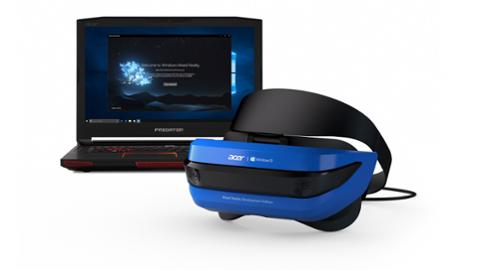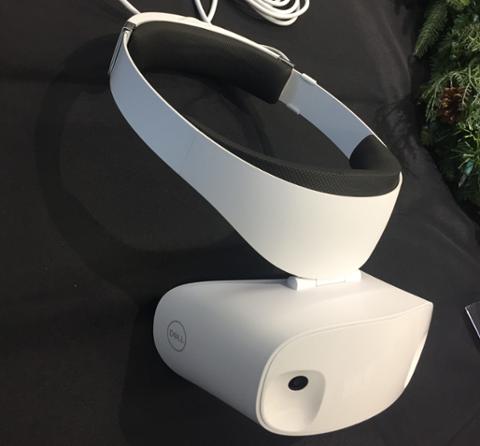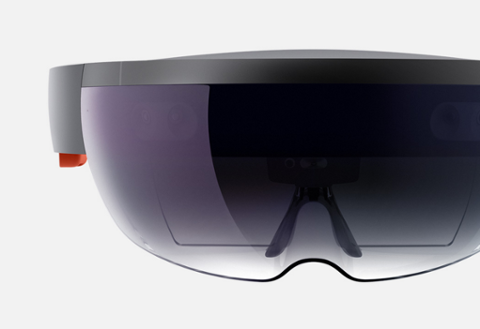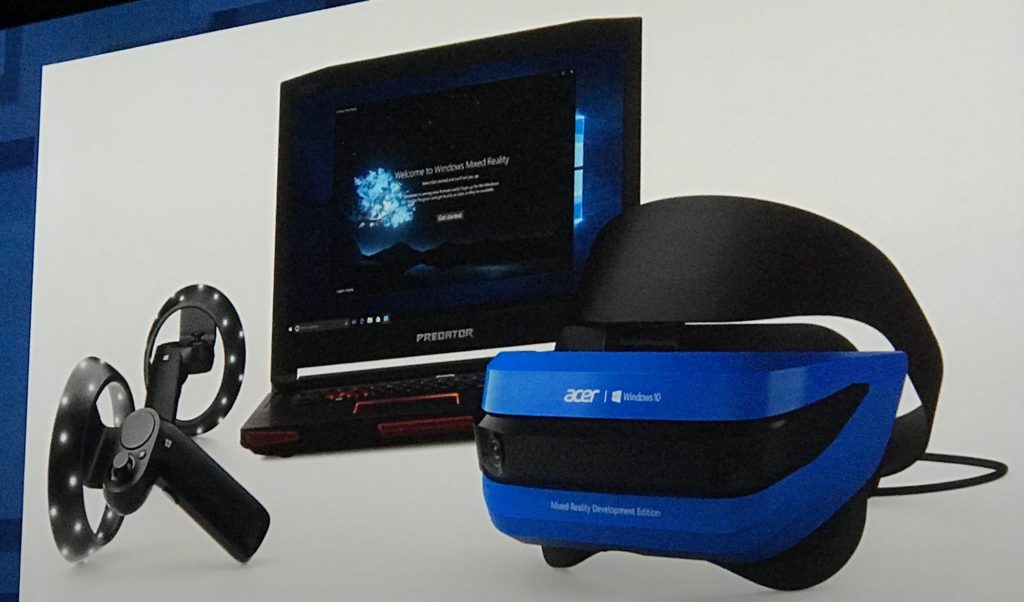
Last week at its annual Build conference, Microsoft executives kept using the term “mixed reality.” “Mixed reality”
(a term that has existed for years) is Microsoft’s attempt to redefine the current paradigm of augmented reality (AR) and virtual reality (VR) devices. Alex Kipman, inventor of the company’s HoloLens headset, told those gathered at Build that AR and VR are just arbitrary labels for “different points” on the “mixed reality continuum.” That attempt at redefinition hasn’t stopped Microsoft from continuing development of the HoloLens, an augmented-reality headset, which currently costs $3,000 for a “Development Edition” (or $5,000 for the “Commercial Suite” version, which includes additional enterprise and security features). Nor are Microsoft’s new “mixed reality” headsets a true blend of AR and VR. If anything, the hardware has much more in common with VR headsets such as the HTC Vive and the Oculus Rift than the HoloLens. Microsoft researchers believe the day will come when all headsets are equally adept at both AR and VR experiences; but that moment, if it ever comes, is still in the future. This current generation features opaque fronts and a pair of high-resolution liquid crystal displays (1440 x 1440). Microsoft has also developed some hand controllers, which look a lot like the ones that currently pair with the Oculus Rift:
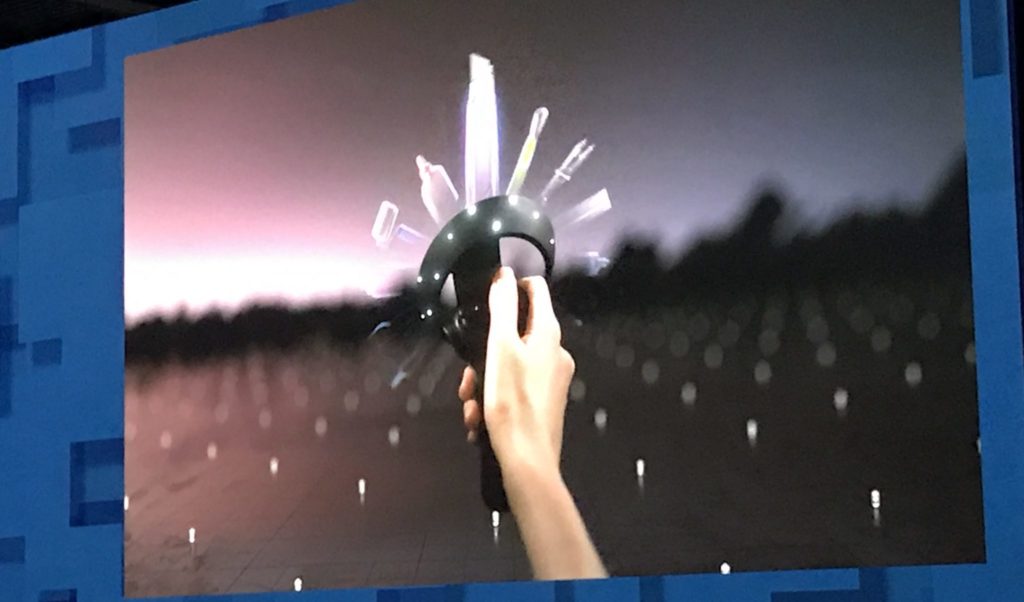
These “mixed reality” headsets do advance the VR game in some ways. For example, the hardware doesn’t require the user to place an external camera or IR emitter in the room in order to accurately track the headset’s position in space. And unlike those higher-priced headsets, which require a PC with an impressive hardware configuration, the first headsets from Hewlett-Packard and Acer can link to a Windows 10 PC with relatively normal specs. Buzzwords aside, Microsoft seems determined to have developers build for this platform. The Windows Dev Center features tools and documentation, as well as the ability to pre-order the dev kit. Microsoft has also released the hardware recommendations for app developers (such as desktops with an Intel Core i7 (6+ Core) or AMD Risen 7 1700 (8 core, 16 threads). As with many gaming and immersive applications, Unity 3D is the dev platform of choice here. If you’re new to Unity, check out its website, which offers a collection of tools and access to a set of (very active) community forums. The good thing here is even if “mixed reality” holds no interest for you as a tech pro, Unity is such an important development tool for other platforms (such as the Nintendo Switch) that you almost can’t lose by learning a little something about it.
 Last week at its annual Build conference, Microsoft executives kept using the term “mixed reality.” “Mixed reality” (a term that has existed for years) is Microsoft’s attempt to redefine the current paradigm of augmented reality (AR) and virtual reality (VR) devices. Alex Kipman, inventor of the company’s HoloLens headset, told those gathered at Build that AR and VR are just arbitrary labels for “different points” on the “mixed reality continuum.” That attempt at redefinition hasn’t stopped Microsoft from continuing development of the HoloLens, an augmented-reality headset, which currently costs $3,000 for a “Development Edition” (or $5,000 for the “Commercial Suite” version, which includes additional enterprise and security features). Nor are Microsoft’s new “mixed reality” headsets a true blend of AR and VR. If anything, the hardware has much more in common with VR headsets such as the HTC Vive and the Oculus Rift than the HoloLens. Microsoft researchers believe the day will come when all headsets are equally adept at both AR and VR experiences; but that moment, if it ever comes, is still in the future. This current generation features opaque fronts and a pair of high-resolution liquid crystal displays (1440 x 1440). Microsoft has also developed some hand controllers, which look a lot like the ones that currently pair with the Oculus Rift:
Last week at its annual Build conference, Microsoft executives kept using the term “mixed reality.” “Mixed reality” (a term that has existed for years) is Microsoft’s attempt to redefine the current paradigm of augmented reality (AR) and virtual reality (VR) devices. Alex Kipman, inventor of the company’s HoloLens headset, told those gathered at Build that AR and VR are just arbitrary labels for “different points” on the “mixed reality continuum.” That attempt at redefinition hasn’t stopped Microsoft from continuing development of the HoloLens, an augmented-reality headset, which currently costs $3,000 for a “Development Edition” (or $5,000 for the “Commercial Suite” version, which includes additional enterprise and security features). Nor are Microsoft’s new “mixed reality” headsets a true blend of AR and VR. If anything, the hardware has much more in common with VR headsets such as the HTC Vive and the Oculus Rift than the HoloLens. Microsoft researchers believe the day will come when all headsets are equally adept at both AR and VR experiences; but that moment, if it ever comes, is still in the future. This current generation features opaque fronts and a pair of high-resolution liquid crystal displays (1440 x 1440). Microsoft has also developed some hand controllers, which look a lot like the ones that currently pair with the Oculus Rift:  These “mixed reality” headsets do advance the VR game in some ways. For example, the hardware doesn’t require the user to place an external camera or IR emitter in the room in order to accurately track the headset’s position in space. And unlike those higher-priced headsets, which require a PC with an impressive hardware configuration, the first headsets from Hewlett-Packard and Acer can link to a Windows 10 PC with relatively normal specs. Buzzwords aside, Microsoft seems determined to have developers build for this platform. The Windows Dev Center features tools and documentation, as well as the ability to pre-order the dev kit. Microsoft has also released the hardware recommendations for app developers (such as desktops with an Intel Core i7 (6+ Core) or AMD Risen 7 1700 (8 core, 16 threads). As with many gaming and immersive applications, Unity 3D is the dev platform of choice here. If you’re new to Unity, check out its website, which offers a collection of tools and access to a set of (very active) community forums. The good thing here is even if “mixed reality” holds no interest for you as a tech pro, Unity is such an important development tool for other platforms (such as the Nintendo Switch) that you almost can’t lose by learning a little something about it.
These “mixed reality” headsets do advance the VR game in some ways. For example, the hardware doesn’t require the user to place an external camera or IR emitter in the room in order to accurately track the headset’s position in space. And unlike those higher-priced headsets, which require a PC with an impressive hardware configuration, the first headsets from Hewlett-Packard and Acer can link to a Windows 10 PC with relatively normal specs. Buzzwords aside, Microsoft seems determined to have developers build for this platform. The Windows Dev Center features tools and documentation, as well as the ability to pre-order the dev kit. Microsoft has also released the hardware recommendations for app developers (such as desktops with an Intel Core i7 (6+ Core) or AMD Risen 7 1700 (8 core, 16 threads). As with many gaming and immersive applications, Unity 3D is the dev platform of choice here. If you’re new to Unity, check out its website, which offers a collection of tools and access to a set of (very active) community forums. The good thing here is even if “mixed reality” holds no interest for you as a tech pro, Unity is such an important development tool for other platforms (such as the Nintendo Switch) that you almost can’t lose by learning a little something about it. 
